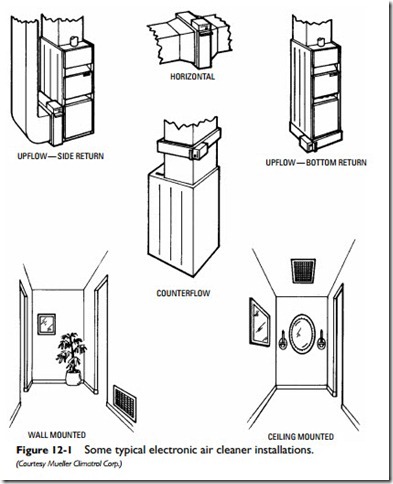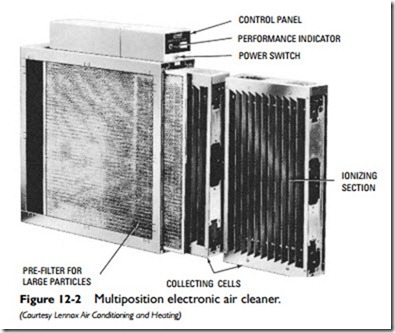All indoor air contains a certain amount of microscopic airborne dust and dirt particles. Cooking and tobacco smoke also contribute to the pollution of the indoor air, and pollen is a factor during some months of the year.
Excessive air pollution stains furniture and fabrics and causes a dust film to form on glass surfaces such as windows or mirrors. It can also be a health problem, especially to those with dust or pollen allergies.
A number of devices are used to remove dust, dirt, smoke, pollen, and other contaminants from the indoor air. They are not all equally effective. For example, an ordinary air filter in a furnace removes only approximately 10 percent of all airborne contaminants. An electronic air cleaner, on the other hand, can remove as much as nine times that amount.
The air-cleaning devices described in this chapter are: (1) electronic air cleaners, (2) air washers, and (3) conventional air filters.
Electronic Air Cleaners
Electronic air cleaners are devices designed to remove airborne particles from the air electrically. The best electronic air cleaners remove 70 to 90 percent of all air contaminants. These standards are met in testing methods devised by the National Bureau of Standards and the Air-Conditioning and Refrigeration Institute. Claims by manufacturers for higher rates of airborne particle removal should be attributed to enthusiasm for their product. In any event, an electronic air cleaner is vastly more effective than the conventional filter used in a warm- air furnace. They are available as permanently mounted units for use in central heating and/or cooling systems or as independent cabinet units.
Permanently mounted electronic air cleaners are installed at the furnace, air handler, or air-conditioning unit or in wall or ceiling return air grilles. Some typical installations are shown in Figure 12-1.
An electronic air cleaner installed at the furnace, air handler, or air-conditioning unit is either mounted against the surface of the unit or a short distance from it on the return air duct. These electronic air cleaners are sometimes referred to as multiposition models because they can be installed in a number of locations with equal
A design feature of some return grille electronic air cleaners is a hinged cell carrier, which swings out to allow the cells to be removed (see Figure 12-5). Return grille electronic air cleaners can be installed in the wall or ceiling openings of return air ducts, but
not in a floor return. These units are also referred to as wall (or ceiling) electronic air cleaners or as through-the-wall electronic air cleaners. Typical installations are shown in Figures 12-6, 12-7, and 12-8.
The independent cabinet units (see Figures 12-9 and 12-10) are designed for use in installations where a permanently mounted unit is impractical or where selective air cleaning is desired. These units can be installed anywhere in the structure.
Based on their operating principle, electronic air cleaners can be divided into the following two principal types:
1. Charged-media air cleaners
2. Two-stage air cleaners

